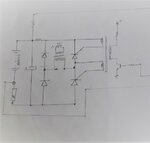UroBoros
Advanced Member level 2
- Joined
- May 5, 2004
- Messages
- 642
- Helped
- 19
- Reputation
- 38
- Reaction score
- 8
- Trophy points
- 1,298
- Location
- Cochin - India
- Activity points
- 6,463

I am Trying to control the DC voltage for a Battery charger using phase control. Basic circuit here.
In the firing position should I send Single Pulse or should I send a pulse train till the end of cycle?
To my Knowledge one the SCR is on, it will remain on till the next zero cross.
I am using a microcntroller to drive the Gate through transistor, but in another analogue circuit when checked in a scope There seems to be a pulse train. I was not able to check it properly.
What is the ideal method in this case?
Thanks